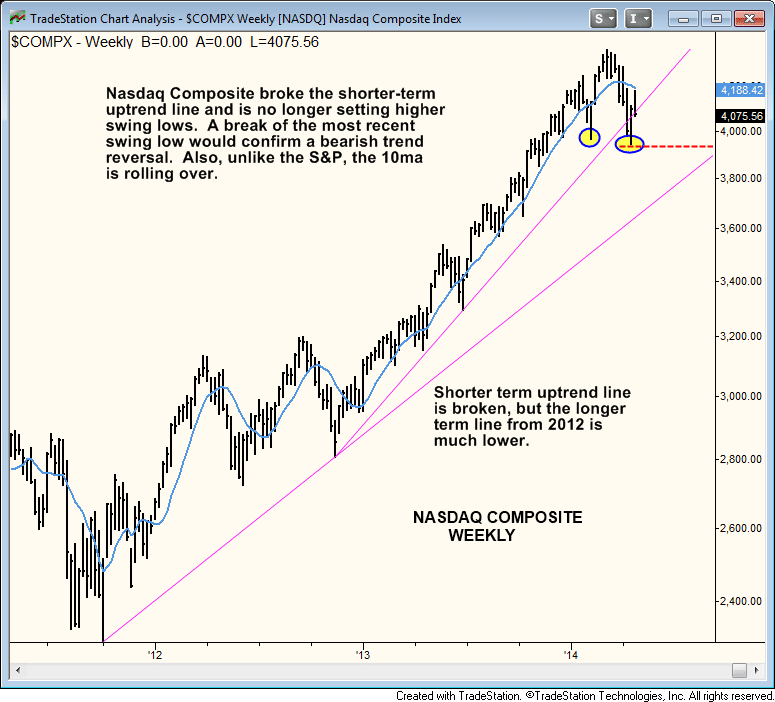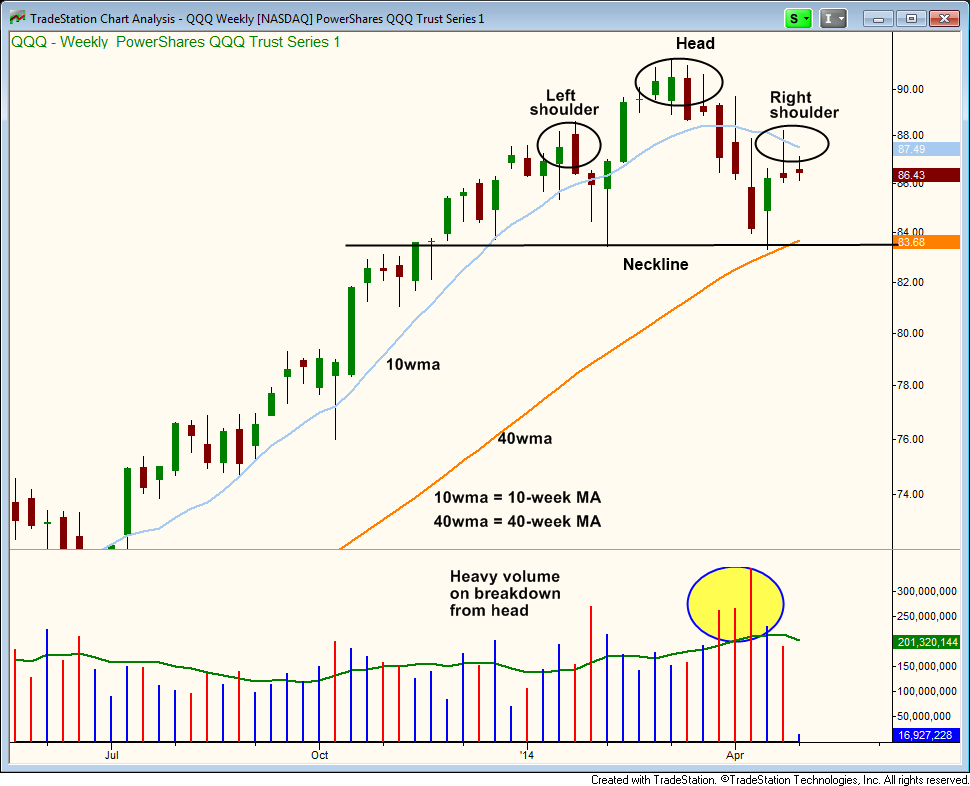 Although my rule-based market timing system has mostly been in “sell” mode for the past month, I have only recently begun looking for stocks and ETFs to sell short because I have been patiently waiting for former leading stocks to start bouncing into their (new) resistance levels.
Although my rule-based market timing system has mostly been in “sell” mode for the past month, I have only recently begun looking for stocks and ETFs to sell short because I have been patiently waiting for former leading stocks to start bouncing into their (new) resistance levels.
Thanks to the bounce off the April 15 lows, followed by last week’s stalling action, both the NASDAQ Composite and NASDAQ 100 indices (the “NASDAQ brothers”) are now poised for lower prices in the coming weeks.
As such, I am now stalking PowerShares QQQ Trust ($QQQ), a popular ETF proxy for the NASDAQ 100 Index, for potential swing trade short entry in my Wagner Daily newsletter.
Following are 3 objective, “no nonsense” reasons why…
1.) Bearish NASDAQ Trend Reversal Now Under Way
The NASDAQ Composite (a broader-based index to follow than the NASDAQ 100) has already broken its uptrend line that began with the lows of late 2012, and is no longer setting “higher highs” and “higher lows” on its weekly chart.
The longer-term uptrend line (from the lows of 2011) is still well below the current price of the NASDAQ, but would likely become a target support level to the downside if market conditions continue to deteriorate:

Considering the NASDAQ has recently broken a 17-month uptrend line and its 10-week moving average (blue line above) is rolling over, negative price momentum is certainly building.
If the NASDAQ cracks below the red horizontal line shown on the chart above, the index will set another “lower low” on the weekly chart.
Also, last week’s high could turn out to be a “lower high” on the weekly chart.
If the NASDAQ breaks below its April 15 low before getting above last week’s high, the index will have formed a “lower high,” followed by a “lower low” on the weekly chart, which would confirm a bearish trend reversal.
2.) Bearish “Head and Shoulders” Pattern
When a stock or index is forming a significant top, a bearish chart pattern known as the “head and shoulders” commonly forms (here is a primer on how the pattern works).

Like every chart pattern, there is never a guarantee that a head and shoulders pattern will follow through to much lower prices.
However, over the years, I have found the head and shoulders to be one of the more reliable chart patterns (but only in a weak or downtrending market). Furthermore, there are…
3 key nuances of the best head and shoulders patterns
- Volume on the right side of the pattern should be heavier than on the left side. This shows heavier selling action (institutional distribution) on the way down versus on the way up to form the “head.”
- Time symmetry is important, meaning the length of time it takes to move from the top of the left shoulder up to the head should be similar or equal to how long it takes to go from the head and down to the top of right shoulder. In this case, I count six weeks on both sides of the head (perfect time symmetry).
- Neckline formed on right side of pattern should be equal to (or slightly lower than) the neckline on the left side of the pattern. This indicates increasing weakness on the test of support.
Since $QQQ is affirmative on all three of the detailed nuances above, I would say this head and shoulders pattern has pretty good odds of following through to the downside.
If it does, the projected decline below the neckline should be roughly equal to the move from the neckline to the top of the head.
3.) Fibonacci And The Shooting Stars
If you’re new to technical analysis, the title of this sub-heading may sound like an Italian rock band, but both terms are actually technical indicators I more frequently use in bearish or downtrending markets.
On April 15, the NASDAQ brothers dipped below pivotal support of their February 5 “swing lows” on an intraday basis, then recovered to close near their highs of the day.
That day’s “shakeout” was followed by a substantial, week-long bounce off the lows, but the buying interest was short-lived and faded just a few days later.
When the price of $QQQ stalled at its declining 10-week moving average, it was roughly equal to a 61.8% Fibonacci retracement (measured from the March 7 high down to the April 15 low).
Then, the NASDAQ brothers formed bearish “shooting star” candlestick patterns on their weekly charts by reversing to close nearly unchanged and at their lows of the week.
Last week’s shooting star in $QQQ (and resistance of the 10-week moving average) is circled on the weekly chart below:

Confirming the 3 reasons I am ready to sell short $QQQ is the continued distribution in former NASDAQ leadership stocks.
Some former NASDAQ leaders that banks, mutual funds, hedge funds, and other institutions have been ditching in recent weeks include: $UA, $AMZN, $NFLX, $CERN, $GOOG, $WYNN, $BIIB, and $PCLN.
As long as leaders like these are being sold with heavy volume, it will be very difficult for the NASDAQ to get its footing.
$QQQ – Why Now Is The Right Time To Sell Short
As explained in this blog post, I am not a big fan of selling short stocks as they are breaking down below support the first time around.
Rather, the low-risk way to sell short stocks and ETFs is to wait for a significant bounce off the lows, followed by a convincing, bearish reversal pattern or gap down.
Since $QQQ neatly fits this criteria, I have placed the ETF on my short selling watchlist (along with a few other stocks such as these).
Rather than selling short $QQQ, traders with non-marginable trading accounts (such as IRAs) may alternatively consider buying the inversely correlated UltraShort QQQ ($QID).
Best designed for short-term trading, rather than “buy and hold” investing, short ETFs such as $QID are a great way for traders with non-marginable accounts to still participate on the short side.
Subscribing members of my nightly swing trading newsletter should note my exact entry, stop, and target prices for this trade setup in the “Watchlist” section of today’s report.
What do you think? Drop us any comments or questions below.

I am new to your service but have a lot of experience with technical analysis. Do you guys look at positive and negative divergences? The NASDAQ had negative(bearish) divergences on the daily and weekly charts, before the selloff.
Hi Mike,
When looking at divergence, we typically use a relative strength line (not RSI) that is plotted to compare any stock or index to the S&P 500. With the way we have chart configured, there was definitely bearish divergence, which confirms the other 3 reasons I think the Nasdaq is heading a bit lower.
Thanks for your comments,
Deron